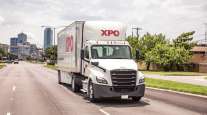LTLs Report Higher Second-Quarter Profits as Business Conditions Continue to Improve
This story appears in the Aug. 4 print edition of Transport Topics.
All but one publicly traded less-than-truckload operation capitalized on improving industry conditions to help companies to achieve higher second-quarter profits.
ABF Freight posted the largest gain of the six earnings reports that rolled in last week, posting LTL profit before interest and taxes of $22.8 million, which quadrupled from $5.5 million. That surge provided most of the earnings growth in parent ArcBest Corp., where net income more than tripled to $17.2 million, or 63 cents per share.
ArcBest previously was known as Arkansas Best Corp.
Likewise, the 51% rise in LTL earnings to $83 million represented the majority of profits that drove the parent’s net income to $53.7 million, or 93 cents, a 25% increase from a year earlier.
Elsewhere, Old Dominion Freight Line’s net income rose 27% to $73.8 million, or 86 cents. The company also had a sector-best 82.5 operating ratio, its best-ever LTL performance.
In addition, revenue rose 8% to $1.49 billion at Con-way Inc., which ranks No. 4 on the Transport Topics Top 100 list of largest for-hire carriers in the United States and Canada.
“Our strategic focus on revenue management was reinforced by strong demand and a firming rate environment,” Con-way CEO Douglas Stotlar said about LTL on July 30, identifying industry conditions that also were cited by other industry leaders.
Con-way Freight posted 5.4% higher revenue of $940.5 million, widening profit primarily through 4.7% higher revenue per 100 pounds of freight.
“As the economy picked up in the second quarter, ABF Freight experienced better pricing conditions and also saw the positive impact from the new labor agreement,” said Judy McReynolds, CEO of ArcBest, No. 13 on the TT Top 100.
Saia Inc.’s net income increased 0.5% to $13.6 million, or 55 cents, held back by accident costs that diluted 13% revenue growth.
No. 5 YRC Worldwide Inc. reported July 31 that it had narrowed its quarterly loss to $4.9 million, or 16 cents per share, from $15.1 million, or $1.72 a share, a year earlier. Revenue improved 6% to $1.32 billion.
Also last week, UPS Inc. said its Freight unit posted better results, without giving details (see story, p. 3). Profit rose 51% in the most recent quarter at FedEx Freight.
The only laggard was Roadrunner Transportation Systems Inc., where higher operating costs reduced LTL profits by 33%.
That cut net income growth, achieved in truckload and brokerage offerings, to 5.7%, or $14.8 million, or 38 cents per share.
Logistics posted 17% more revenue at $433.7 million and raised profit before interest and taxes 7% to $6.42 million over last year’s quarter, when earnings were reduced $3.7 million by a one-time charge. Con-way Truckload profit also rose.
At ArcBest, ABF shipments rose 6%, and rates reflected in revenue per 100 pounds of freight increased 4.2%. The Logistics income on the same basis was $6.5 million, an improvement of 73% that was generated by the Panther Premium Logistics unit.
ArcBest raised revenue 14% to $658.6 million from $576.9 million, mostly because of logistics revenue that rose nearly 30% to $178.1 million. ABF Freight contributed 10% more revenue, rising to $492.9 million from $446.8 million.
Old Dominion, No. 12, posted 19% revenue growth, the best in the group, rising to $703 million. The results included 15% more tonnage, 12% more shipments handled and 6.4% higher revenue per shipment.
Roadrunner, ranked at No. 21, said its weaker LTL results, tied to higher insurance and claims costs, were being turned around in the current quarter. LTL revenue grew just 2% to $150.2 million, the lowest growth among its peers in the quarter.
No. 25 Saia’s revenue jumped 13% to $330 million, the largest increase in seven years, as LTL shipments rose 5.5% and tonnage gained 6.9%.
Rising claims and insurance costs also hurt Saia, where those expenses shaved profits by $8.3 million. Its profit before interest and taxes fell 2% to $22.7 million.
“Last year’s investment in sales and marketing resources, coupled with effective yield management, provided the opportunity to overcome a capacity-constrained environment, which significantly increased costs for driver recruiting, training and purchased transportation,” CEO Rick O’Dell said in a statement.




